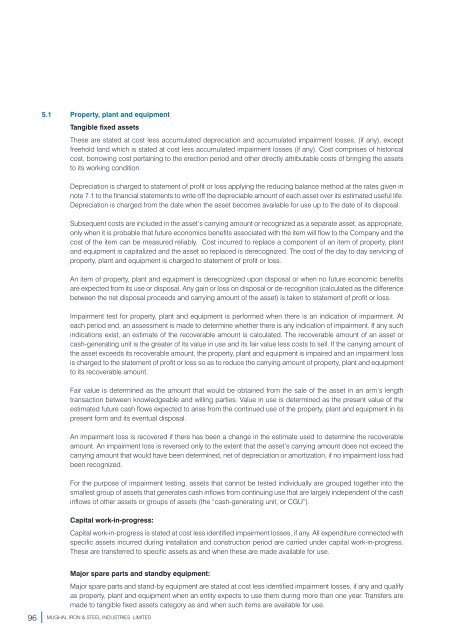MS AR 2018 (1)
Create successful ePaper yourself
Turn your PDF publications into a flip-book with our unique Google optimized e-Paper software.
5.1 Property, plant and equipment<br />
Tangible fixed assets<br />
These are stated at cost less accumulated depreciation and accumulated impairment losses, (if any), except<br />
freehold land which is stated at cost less accumulated impairment losses (if any). Cost comprises of historical<br />
cost, borrowing cost pertaining to the erection period and other directly attributable costs of bringing the assets<br />
to its working condition.<br />
Depreciation is charged to statement of profit or loss applying the reducing balance method at the rates given in<br />
note 7.1 to the financial statements to write off the depreciable amount of each asset over its estimated useful life.<br />
Depreciation is charged from the date when the asset becomes available for use up to the date of its disposal.<br />
Subsequent costs are included in the asset’s carrying amount or recognized as a separate asset, as appropriate,<br />
only when it is probable that future economics benefits associated with the item will flow to the Company and the<br />
cost of the item can be measured reliably. Cost incurred to replace a component of an item of property, plant<br />
and equipment is capitalized and the asset so replaced is derecognized. The cost of the day to day servicing of<br />
property, plant and equipment is charged to statement of profit or loss.<br />
An item of property, plant and equipment is derecognized upon disposal or when no future economic benefits<br />
are expected from its use or disposal. Any gain or loss on disposal or de-recognition (calculated as the difference<br />
between the net disposal proceeds and carrying amount of the asset) is taken to statement of profit or loss.<br />
Impairment test for property, plant and equipment is performed when there is an indication of impairment. At<br />
each period end, an assessment is made to determine whether there is any indication of impairment. If any such<br />
indications exist, an estimate of the recoverable amount is calculated. The recoverable amount of an asset or<br />
cash-generating unit is the greater of its value in use and its fair value less costs to sell. If the carrying amount of<br />
the asset exceeds its recoverable amount, the property, plant and equipment is impaired and an impairment loss<br />
is charged to the statement of profit or loss so as to reduce the carrying amount of property, plant and equipment<br />
to its recoverable amount.<br />
Fair value is determined as the amount that would be obtained from the sale of the asset in an arm’s length<br />
transaction between knowledgeable and willing parties. Value in use is determined as the present value of the<br />
estimated future cash flows expected to arise from the continued use of the property, plant and equipment in its<br />
present form and its eventual disposal.<br />
An impairment loss is recovered if there has been a change in the estimate used to determine the recoverable<br />
amount. An impairment loss is reversed only to the extent that the asset’s carrying amount does not exceed the<br />
carrying amount that would have been determined, net of depreciation or amortization, if no impairment loss had<br />
been recognized.<br />
For the purpose of impairment testing, assets that cannot be tested individually are grouped together into the<br />
smallest group of assets that generates cash inflows from continuing use that are largely independent of the cash<br />
inflows of other assets or groups of assets (the “cash-generating unit, or CGU”).<br />
Capital work-in-progress:<br />
Capital work-in-progress is stated at cost less identified impairment losses, if any. All expenditure connected with<br />
specific assets incurred during installation and construction period are carried under capital work-in-progress.<br />
These are transferred to specific assets as and when these are made available for use.<br />
Major spare parts and standby equipment:<br />
Major spare parts and stand-by equipment are stated at cost less identified impairment losses, if any and qualify<br />
as property, plant and equipment when an entity expects to use them during more than one year. Transfers are<br />
made to tangible fixed assets category as and when such items are available for use.<br />
96 MUGHAL IRON & STEEL INDUSTRIES LIMITED


